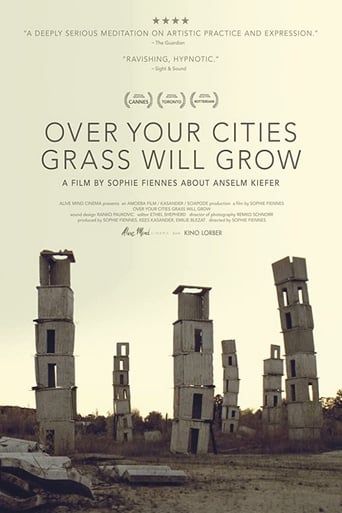

Slow pace in the most part of the movie.
... View MoreFantastic!
... View MoreExcellent and certainly provocative... If nothing else, the film is a real conversation starter.
... View MoreIt is interesting even when nothing much happens, which is for most of its 3-hour running time. Read full review
... View MoreDeeply meditative film, by which I don't mean boring. It's a film that demands a lot of concentration. Aselm Kiefer is a German artist working in France. The film is quite simple in trying to show and not tell us how Kiefer works and the strange artworks he produces in what looks like an abandoned village. Are they really artworks? Some of the things he makes are difficult to categorize. Sculptures that look like piles of rubble, because they are. Or are they? Does the artist's involvement make them other? Reminded me of Tarkovsky at times with all the underground scenes of strange environments.
... View MoreI've come late in life to watching Art Documentaries. Over Your Cities Grass Will Grow was one of the first for me, so my measurement of it had little for comparison. Seven years later, having seen many dozens more (around 60), I have to say this ranks up there with the best. It had the same level of impact as films like Statues Also Die (1953), In The Realms of The Unreal (2004), Brief Encounters (2012), Europe After The Rain (1978) or A Brush With Violence (2017). That many years later, I still reflect on it from time to time. Kudos to Sophie Fiennes.
... View MoreI viewed 8 minutes of the movie before rushing to turn the console off because my dislike kept growing more and more powerful. This strong reaction was followed by a much longer period of time spent trying to understand why I reacted so negatively. The conclusion I came to was that the director, Sophie Fiennes, was probably a young filmmaker whose immaturity allowed herself to be swayed by the person who composed the music. The music was the main component that made the movie unbearable and I thought Ms. Fiennes simply didn't realize that the score should serve to tell the story, not dominate it. Then I discovered that Ms. Fiennes was born in 1967, not 1992 and so have no idea why someone of her age and film-making experience would make such a rookie mistake.
... View MoreThe film begins with a long exploration like "The Zone" from Tarkovsky's Stalker: bushes glimpsed derelict tunnels, shelves of books made of lead with rocks on them, more leaden books with fragments of glass in and around them, light from overhead windows shines on rubble and dust- filled corridors. Music by Ligoti accompanies it. After some time- more than ten minutes at a guess- the first human appears, charring sets of- paper- books in a furnace. He is one of Anselm Kiefer's assistants at this strange studio or workshop- a derelict silk factory, where Kiefer adds deliberate ruins to the accidental ones. We see Kiefer's working methods- both aleatoric and industrial in their own way- enormous paintings- of tree trunks on glass, of a man or corpse on his back- a strange self-portrait, perhaps- the only painting we see not exclusively involving black, white and grey- and watch his working methods- glue and then a powder- dust or paint- is scattered on a painting on the ground and a crane slowly hoists the painting up to display it while much of the powder falls off; a strange sculpture of a deformed ship is stuck to a seascape, hiding the artist's palette which was there before. Next there is an interview with Kiefer in the library. We never see what any of the books in the library are and Kiefer does not refer to any other artists, only to the bible and the Kabbalist Solomon Luria and the Rosicrucian Robert Fludd. Nor do we learn more of Kiefer- are the children who appear in the library his children, his grandchildren or someone else's? We never learn how his extraordinary work is paid for either. At one point the interviewer says that nothing is written on the blank pages of the lead books- no, says Kiefer, everything is written there. At no time is there a discussion of the quality of Kiefer's art or the history and influences behind it. Its value is taken as a given. In the second half we see how the sculptures are made and someone excavates an underground amphitheatre, for an unknown end. Kiefer and his assistants pour molten lead down a mound of earth, help the lead form a cascade and melt a leaden book at the bottom- it seems important that the book be melted, rather than raw lead be used. They pay no attention to health or safety regulations, never wearing protective masks or clothing, no matter how potentially lethal the material they work with. Finally, they put up artificial ruins, already fragmentary walls of concrete that rest on the leaden books and make brittle piles in the sky, haunts for Lilith the she-demon, Kiefer says. He announces, casually, that he is going to a new studio in Paris; over a hundred lorries have already moved things, and this studio will be abandoned, a painting or sculpture left in each building to decay with the building. The film ends with another survey accompanied by Ligoti's music, this time of the ruins in air waiting to decay and fall as if Ozymandias had designed his statue as a ruin.
... View More